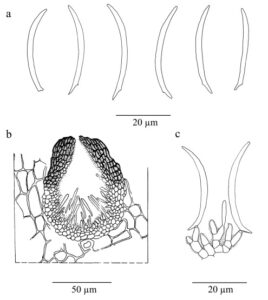Aphanofalx B. Sutton, Trans. Br. Mycol. Soc. 86(1): 21 (1986)
Index Fungorum number: IF 11021, MycoBank number: MB 11021, Facesofungi number: FoF 07113, Fig. 1
Saprobic on the host plant. Sexual morph: undetermined. Asexual morph: Conidiomata black, pycnidial, scattered to gregarious, immersed to semi-immersed, globose to subglobose or oval, unilocular, glabrous, ostiolate. Ostiole single, circular or oval, centrally located. Conidiomatal wall composed of thick-walled, brown to hyaline cells of textura angularis, becoming darker at the ostiolar region. Conidiophores formed from the innermost layer wall cells of the conidiomata, hyaline, short-cylindrical to doliiform, branched, and septate, smooth-walled, invested in mucus. Conidiogenous cells hyaline, enteroblastic, annellidic, cylindrical or lageniform, integrated or discrete, indeterminate, smooth-walled, with numerous inconspicuous to conspicuous percurrent proliferations toward the apex. Conidia hyaline, fusiform, lunate or irregular, curved, unicellular, smooth-walled, bearing a broad tubular, plectronoid to podiform, unbranched, excentric basal appendage (Nag Raj 1993).
Type species – Aphanofalx mali B. Sutton, Trans. Br. Mycol. Soc. 86(1): 22 (1986)
Notes – Two species, Aphanofalx irregularis B. Sutton & Abbas on twigs of Salvadora oleoides (Salvadoraceae) and A. mali B. Sutton on lenticels of Malus pumila (Rosaceae) were accepted in Aphanofalx (Nag Raj 1993). Aphanofalx shares a similar form of conidiomata, conidiogenous cells and conidia with Pseudoseptoria, but is distinguished by its conidia bearing a basal appendage. There is no molecular data available for this genus.
Distribution – Pakistan, Zambia (Nag Raj 1993)

